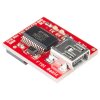View attachment 4068342 View attachment 4068343
reboard#1 is the board with the 2 rotary encoders. In the pictures is a prototype. On the reboard#1 are schmitt triggers and CD4013 D Flip-Flop‘s to make it easy to read the output from the rotary encoders.
http://www.bristolwatch.com/ele2/rotary.htm
You can choose in a setup menu if you want to use your fixture via your home netwerk, cloud based or as a webserver.
The display and camera work with the SPI and I2C protocol. The sensors work with the Onewire protocol. Because al that protocols used up almost all the pins on the ESP i used an MCP23017 port expander to read the input from the rotary encoders and to switch the 5 relais, the fans and the backlight of the display. The MCP23017 works with the I2C protocol.
The dimming is done by a PCA8695 PWM IC. It is 12 bit and has 16 ports. It works with the I2C protocol. I only use 2 ports for 2 hlg drivers.
The clock is a DS3231 that also works with the I2C protocol. A clock is nescesary If the WiFi signal drops.
The camera is send via WiFi to a home server (raspberry pi with a harddisk) or to the cloud. Very nice for high resolution time lapse video’s.




